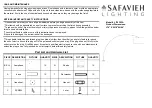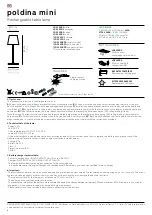
6.
Connect remote lamps (if used) to blue (+, fused) and yellow (–) leads
(10)
(Fig. 2 or Fig. 3).
7.
Connect 120 or 277VAC input connections to transformer
(Fig. 2 or Fig. 3)
. Connect green wire to
building ground.
Note
: insulate the unused transformer lead to prevent potential shock hazard.
Depending on the type of unit battery, follow steps 8 through 16 below.
• Units Supplied With Lead-Calcium Batteries
8.
Place battery
(8)
into housing
(2)
.
9.
Determine proper battery orientation from
Fig. 2
(single harness lead connection). Battery is positioned to the left of the circuit
board.
10.
Connect positive
(+, red)
and negative
(–, yellow)
battery harness leads from printed circuit board to corresponding battery
terminals as shown in
Fig. 2
.
11.
Check all wiring for loose or missing connections.
12.
Replace cover. Tighten cover screws.
13.
Aim lamp heads
(5)
to properly illuminate the path of egress.
14.
Energize unit with AC power.
Note: Allow unit to charge for 24 hours prior to performing initial test.
15.
Press and hold the “TEST” button (see
Fig. 2
for
“TEST”
button location) to confirm illumination and proper aiming of
emergency lamps. (
“AC ON”
indicator LED should go off). Release the
“TEST”
button; emergency lamps should extinguish.
Normal operation begins.
16.
Normal Operation: with power supplied,
“AC ON”
LED indicator is illuminated and emergency lamps are off.
• Units Supplied With Nickel Cadmium Batteries
8.
Place battery
(8)
into housing
(2)
.
9.
Determine proper battery orientation from
Fig. 3
(single or double harness lead connections). Battery is positioned to the left of
the circuit board.
10.
Connect battery harness leads from printed circuit board to corresponding battery harness leads as shown in
Fig. 3
.
11.
Check all wiring for loose or missing connections.
12.
Replace cover. Tighten cover screws.
13.
Aim lamp heads
(5)
to properly illuminate the path of egress.
14.
Energize unit with AC power.
Note: Allow unit to charge for 24 hours prior to performing initial test.
15.
Press and hold the “TEST” button (see
Fig. 3
for
“TEST”
button location) to confirm illumination and proper aiming of
emergency lamps. (
“AC ON”
indicator LED should go off). Release the
“TEST”
button; emergency lamps should extinguish.
Normal operation begins.
16.
Normal Operation: with power supplied,
“AC ON”
LED indicator is illuminated and emergency lamps are off.
ROUTINE TEST CYCLING
1.
Every three (3) months: If there has been no power failure, press and hold the
“TEST”
button for at least thirty (30) seconds to
confirm emergency lamp operation. Release
“TEST”
button to return to battery charging mode.
2.
Once a year: Perform a full battery conditioning cycle by de-energizing the AC circuit to which the unit is connected, and allow
the unit to operate for ninety (90) minutes on battery power. Following successful test, energize AC circuit to begin battery
charging cycle.
REPLACING EMERGENCY LAMPS AND BATTERIES
General
a. De-energize the AC power supply to the unit.
b. Remove enclosure cover.
c. Disconnect positive (+, red) battery lead
(nickel cadmium models- disconnect battery and printed circuit board connectors).
• Replacing Unit Emergency Lamp
• Replacing Unit Battery
1.
Remove diffuser lens from
1.
Remove defective battery. Recycle responsibly.
lamp housing by prying lens
Replace with genuine Prescolite battery.
adjacent to tab slot (see
Fig.4
)
2.
Place new battery in enclosure. Make
2.
Remove and replace lamp.
connections following steps outlined above.
(refer to unit product label
3.
Test unit.
for specific lamp type)
Fig. 1
Fig. 3
Single and Double Harness Lead
Connections
Nickel-Cadmium Battery Models
Fig. 2
Single Harness Lead Connection
Lead-Calcium Battery Models
Fig. 4




















